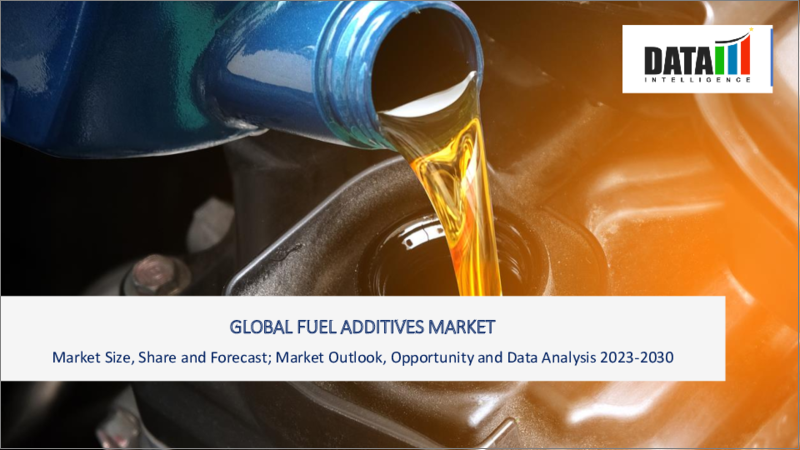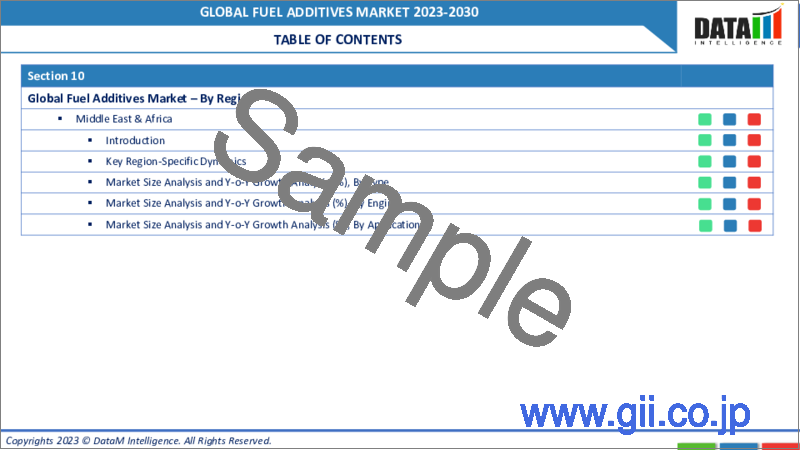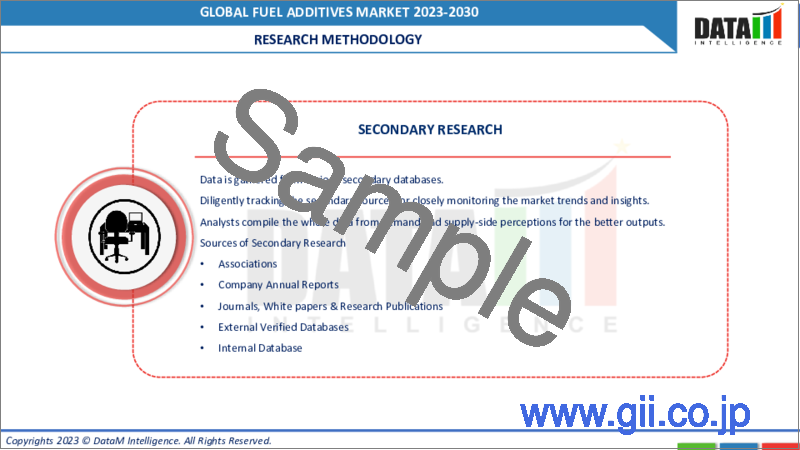|
|
市場調査レポート
商品コード
1255840
燃料添加剤の世界市場- 2023-2030年Global Fuel Additives Market - 2023-2030 |
||||||
|
● お客様のご希望に応じて、既存データの加工や未掲載情報(例:国別セグメント)の追加などの対応が可能です。 詳細はお問い合わせください。 |
|||||||
| 燃料添加剤の世界市場- 2023-2030年 |
|
出版日: 2023年04月11日
発行: DataM Intelligence
ページ情報: 英文 215 Pages
納期: 約2営業日
|
- 全表示
- 概要
- 目次
市場概要
世界の燃料添加剤市場は、有利な成長を遂げると予測されています。予測期間中(2023-2030年)、市場は堅調に成長しています。
燃料添加剤は、自動車の燃料の性能と品質を向上させるために作られます。燃料のオクタン価を高めたり、腐食防止剤や潤滑剤として機能し、効率とパワーを向上させるために高い圧縮比を使用できるようにするものです。燃料添加剤は、自動車に使用する燃料の性能を向上させ、特定の排出ガスを低減させるために使用されます。一般的に、ガソリン添加剤は腐食防止剤、潤滑剤、オクタン価ブースターとして機能します。
市場力学
製油所での使用が増えていること
製油所では、ガソリンの品質向上、燃料規格基準への適合、燃料品質の向上を目的に、製造工程でも燃料添加剤が適用されます。また、全体的な収益性や燃費を向上させます。液化石油ガス(LPG)、圧縮天然ガス、バイオ燃料、超低硫黄ディーゼルは、いずれも燃料として認められます。国際エネルギー機関(IEA)は、好調な世界経済により、世界の石油需要は年平均120mb/dの伸びを示すと予測しています。その結果、ガソリン添加剤市場は、石油需要が104.7 mb/dに達する2023年までに急速な拡大を経験することになります。
効率的で低排出ガスな燃料への需要の高まり
交通渋滞の増加や超低硫黄ディーゼルの普及に加え、効率的で低排出ガスな自動車燃料への需要が急速に高まっていることが、世界の燃料添加剤市場拡大の主な要因となっています。中国は、外国貿易・投資に関する有利なルールにより、過去30年間で工業化が飛躍的に拡大し、燃料添加剤の需要に直接的な影響を与えています。また、燃料添加剤の主要ユーザーである自動車産業は、燃料添加剤の世界市場の主要な促進要因となっています。
COVID-19の影響分析
COVID-19分析では、COVID前シナリオ、COVIDシナリオ、COVID後シナリオに加え、価格力学(パンデミック時やCOVID前シナリオとの比較による価格変動を含む)、需要-供給スペクトラム(取引制限、封鎖、その後の問題による需要と供給のシフト)、政府の取り組み(政府機関による市場、セクター、産業の活性化に関する取り組み)、メーカーの戦略的取り組み(COVID問題を軽減するためのメーカーの取り組み)についても解説しています。
目次
第1章 調査手法と範囲
- 調査手法
- 調査目的および調査範囲について
第2章 定義と概要
第3章 エグゼクティブサマリー
- タイプ別市場内訳
- エンジンタイプ別市場内訳
- アプリケーション別市場内訳
- 地域別市場内訳
第4章 市場力学
- 影響要因
- 促進要因
- 燃料添加剤の開発・技術革新が進む
- 燃料の消費量が増加
- 抑制要因
- バッテリーEVの需要拡大
- 機会
- 影響分析
- 促進要因
第5章 産業分析
- ポーターのファイブフォース分析
- サプライチェーン分析
- 価格分析
- 規制分析
第6章 COVID-19の分析
- COVID-19の解析について
- COVID-19シナリオ前
- 現在のCOVID-19シナリオ
- ポストCOVID-19または将来のシナリオ
- COVID-19 の中での価格変動
- 需給スペクトル
- パンデミック時の市場に関連する政府の取り組み
- メーカーの戦略的な取り組み
- 結論
第7章 タイプ別
- セタン価向上剤
- 鉛のアンチノック添加剤
- 染料・マーカー
- 酸化防止剤
- 金属不活性化剤
- 腐食防止剤
- 凍結防止用添加剤
- コールドフロー改善剤
- 硫化水素捕捉剤
- デポジットコントロール添加剤
- 消泡添加剤
- 潤滑性向上剤
- 流動点降下剤(PPDs)
- 安定性向上剤
- オクタン価向上剤
- その他
第8章 エンジンタイプ別
- 2サイクルエンジン
- ガソリンエンジン
- ディーゼルエンジン
- ガスエンジン
- 4ストロークエンジン
- ガソリンエンジン
- ディーゼルエンジン
- ガスエンジン
- その他
第9章 アプリケーション別
- ガソリン
- デポジットコントロール添加剤
- セタン価向上剤
- 酸化防止剤
- 染料・マーカー
- 潤滑性向上剤
- コールドフロー改善剤
- 安定性向上剤
- 腐食防止剤
- オクタン価向上剤
- 凍結防止剤
- 流動点降下剤(PPDs)
- その他
- ディーゼル
- セタン価向上剤
- コールドフロー改善剤
- デポジットコントロール添加剤
- 消泡添加剤
- 潤滑性向上剤
- 流動点降下剤(PPDs)
- 鉛のアンチノック添加剤
- 染料・マーカー
- 酸化防止剤
- 金属不活性化剤
- 腐食防止剤
- 凍結防止用添加剤
- 硫化水素スカベンジャー
- その他
- 航空燃料
- マリンフューエル
第10章 地域別
- 北米
- 米国
- カナダ
- メキシコ
- 欧州
- ドイツ
- 英国
- フランス
- イタリア
- スペイン
- その他欧州
- 南米
- ブラジル
- アルゼンチン
- その他南米地域
- アジア太平洋地域
- 中国
- インド
- 日本
- オーストラリア
- その他アジア太平洋地域
- 中東・アフリカ地域
第11章 競合情勢について
- 競合シナリオ
- 市況分析・シェア分析
- M&A分析
第12章 企業プロファイル
- Evonik Industries
- 会社概要
- 製品ポートフォリオと説明
- 主なハイライト
- 財務概要
- Innospec
- Lubrizol
- Croda
- Afton Chemical
- Total SE
- Arkema
- BASF SE
- Dorf Ketal
- Dow Chemical
第13章 付録
- 私たちとサービスについて
- お問い合わせ
Market Overview
The global fuel additives market reached US$ XX million in 2022 and is projected to witness lucrative growth by reaching up to US$ XX million by 2030. The market is growing at a CAGR of XX% during the forecast period (2023-2030).
Fuel additives are created to enhance the performance and quality of fuels in automobiles. They boost the octane rating of a fuel or function as corrosion inhibitors or lubricants, enabling the use of higher compression ratios for improved efficiency and power. Fuel additives are used to increase the performance of fuel in cars and lower certain emissions. Typically, gasoline additives work as corrosion inhibitors, lubricants or octane rating boosters.
Market Dynamics
The growing use in refineries
At refineries, fuel additives are also applied during the production process to increase gasoline quality, ensure compliance with fuel specification standards and improve fuel quality. Also, it improves overall profitability and fuel efficiency. Liquefied petroleum gas (LPG), compressed natural gas, biofuel or ultra-low sulphur diesel are all acceptable forms of fuel. The International Energy Agency (IEA) predicts that a strong global economy will result in an average annual growth of 1.2 mb/d in global oil demand. As a result, the gasoline additives market will experience rapid expansion by 2023, when the oil demand will reach 104.7 mb/d.
The growing demand for efficient and low-emission fuels
The rapid rise in demand for efficient and low-emission fuels from automobiles, together with an increase in traffic congestion and the spread of ultralow sulphur diesel, are the main factors propelling the expansion of the worldwide fuel additive market. Due to favorable rules for foreign trade and investment, China has experienced tremendous industrialization expansion over the past 30 years, which has a direct impact on the need for fuel additives. Also, as the primary user of fuel additives, the automobile industry serves as a major driver of the global market for fuel additives.
COVID-19 Impact Analysis
The COVID-19 Analysis includes Pre-COVID Scenario, COVID Scenario and Post-COVID Scenario along with Pricing Dynamics (Including pricing change during and post-pandemic comparing it with pre-COVID scenarios), Demand-Supply Spectrum (Shift in demand and supply owing to trading restrictions, lockdown and subsequent issues), Government Initiatives (Initiatives to revive market, sector or Industry by Government Bodies) and Manufacturers Strategic Initiatives (What manufacturers did to mitigate the COVID issues will be covered here).
Segment Analysis
The global fuel additives market is segmented based on type, engine type, application and region.
The high efficiency and flexibility of stationary application
Over the projection period, it is predicted that the diesel category will expand and keep a sizeable proportion. Diesel fuel is more harmful to the environment than other types of gasoline, hence it requires more fuel additives to maximize a vehicle's fuel efficiency. Developing nations like China, India, Indonesia, Thailand and Indonesia are the main drivers of this market. In the upcoming years, it is anticipated that the demand for fuel additives would increase due to the rising use of ULSD-Ultra-low sulfur diesel in North America and Europe, which necessitates a significant number of fuel additives.
Geographical Analysis
The growing demand for clean energy in Asia-Pacific
The region expected to experience the highest increase for gasoline additives over the projected period is Asia-Pacific. Due to rising industrialization, the need for greater efficiency and the implementation of strict emission control regulations in China, India and Japan, it is predicted to rise at the quickest CAGR. Over the projection period, Asia-Pacific's rapidly expanding automotive industry will undoubtedly have a beneficial impact on demand for fuel supplements.
Competitive Landscape
The major global players in the market are: Evonik Industries, Innospec, Lubrizol, Croda, Afton Chemical, Total SE, Arkema, BASF SE, Total SE, Dorf Ketal and Dow Chemical.
Why Purchase the Report?
- To visualize the global fuel additives- market segmentation based on type, engine type, application and region, as well as understand key commercial assets and players.
- Identify commercial opportunities by analyzing trends and co-development.
- Excel data sheet with numerous data points of fuel additives market-level with all segments.
- PDF report consists of a comprehensive analysis after exhaustive qualitative interviews and an in-depth study.
- Product mapping available as excel consisting of key products of all the major players.
The global fuel additives market report would provide approximately 61 tables, 70 figures and 215 pages.
Target Audience 2023
- Manufacturers/ Buyers
- Industry Investors/Investment Bankers
- Research Professionals
- Emerging Companies
Table of Contents
1. Methodology and Scope
- 1.1. Research Methodology
- 1.2. Research Objective and Scope of the Report
2. Definition and Overview
3. Executive Summary
- 3.1. Market Snippet By Type
- 3.2. Market Snippet By Engine Type
- 3.3. Market Snippet By Application
- 3.4. Market Snippet By Region
4. Dynamics
- 4.1. Impacting Factors
- 4.1.1. Drivers
- 4.1.1.1. The growing development and innovations in fuel additives
- 4.1.1.2. The rising consumption of fuel
- 4.1.2. Restraints
- 4.1.2.1. The growing demand for battery EVs
- 4.1.2.2. XX
- 4.1.3. Opportunity
- 4.1.3.1. XX
- 4.1.4. Impact Analysis
- 4.1.1. Drivers
5. Industry Analysis
- 5.1. Porter's Five Forces Analysis
- 5.2. Supply Chain Analysis
- 5.3. Pricing Analysis
- 5.4. Regulatory Analysis
6. COVID-19 Analysis
- 6.1. Analysis of COVID-19
- 6.1.1. Before COVID-19 Scenario
- 6.1.2. Present COVID-19 Scenario
- 6.1.3. Post COVID-19 or Future Scenario
- 6.2. Pricing Dynamics Amid COVID-19
- 6.3. Demand-Supply Spectrum
- 6.4. Government Initiatives Related to the Market During Pandemic
- 6.5. Manufacturers Strategic Initiatives
- 6.6. Conclusion
7. By Type
- 7.1. Introduction
- 7.1.1. Market Size Analysis and Y-o-Y Growth Analysis (%), By Type
- 7.1.2. Market Attractiveness Index, By Type
- 7.2. Cetane Number Improvers*
- 7.2.1. Introduction
- 7.2.2. Market Size Analysis and Y-o-Y Growth Analysis (%)
- 7.3. Lead Anti-Knock Additive
- 7.4. Dyes/Markers
- 7.5. Antioxidants
- 7.6. Metal deactivators
- 7.7. Corrosion inhibitors
- 7.8. Anti-icing additives
- 7.9. Cold flow improvers
- 7.10. Hydrogen Sulphide Scavengers
- 7.11. Deposit Control Additives
- 7.12. Anti-Foam Additives
- 7.13. Lubricity Improvers
- 7.14. Pour Point Depressants (PPDs)
- 7.15. Stability Improvers
- 7.16. Octane Improvers
- 7.17. Others
8. By Engine Type
- 8.1. Introduction
- 8.1.1. Market Size Analysis and Y-o-Y Growth Analysis (%), By Engine Type
- 8.1.2. Market Attractiveness Index, By Engine Type
- 8.2. Two-stroke Engine*
- 8.2.1. Introduction
- 8.2.2. Market Size Analysis and Y-o-Y Growth Analysis (%)
- 8.2.3. Gasoline Engine
- 8.2.4. Diesel Engine
- 8.2.5. Gas Engine
- 8.3. Four-stroke Engine
- 8.3.1. Gasoline Engine
- 8.3.2. Diesel Engine
- 8.3.3. Gas Engine
- 8.3.4. Others
9. By Application
- 9.1. Introduction
- 9.1.1. Market Size Analysis and Y-o-Y Growth Analysis (%), By Application
- 9.1.2. Market Attractiveness Index, By Application
- 9.2. Gasoline*
- 9.2.1. Introduction
- 9.2.2. Market Size Analysis and Y-o-Y Growth Analysis (%)
- 9.2.3. Deposit Control Additives
- 9.2.4. Cetane Improvers
- 9.2.5. Antioxidants
- 9.2.6. Dyes & Markers
- 9.2.7. Lubricity Improvers
- 9.2.8. Cold Flow Improvers
- 9.2.9. Stability Improvers
- 9.2.10. Corrosion Inhibitors
- 9.2.11. Octane Improvers
- 9.2.12. Anti-icing Agents
- 9.2.13. Pour Point Depressants (PPDs)
- 9.2.14. Others
- 9.3. Diesel
- 9.3.1. Cetane Number Improvers
- 9.3.2. Cold Flow Improvers
- 9.3.3. Deposit Control Additives
- 9.3.4. Anti-Foam Additives
- 9.3.5. Lubricity Improvers
- 9.3.6. Pour Point Depressants (PPDs)
- 9.3.7. Lead Anti-Knock Additive
- 9.3.8. Dyes/Markers
- 9.3.9. Antioxidants
- 9.3.10. Metal Deactivators
- 9.3.11. Corrosion Inhibitors
- 9.3.12. Anti-icing Additives
- 9.3.13. Hydrogen Sulfide Scavengers
- 9.3.14. Others
- 9.4. Aviation Fuel
- 9.5. Marine Fuel
10. By Region
- 10.1. Introduction
- 10.2. Market Size Analysis and Y-o-Y Growth Analysis (%), By Region
- 10.3. Market Attractiveness Index, By Region
- 10.4. North America
- 10.4.1. Introduction
- 10.4.2. Key Region-Specific Dynamics
- 10.4.3. Market Size Analysis and Y-o-Y Growth Analysis (%), By Type
- 10.4.4. Market Size Analysis and Y-o-Y Growth Analysis (%), By Engine Type
- 10.4.5. Market Size Analysis and Y-o-Y Growth Analysis (%), By Application
- 10.4.6. Market Size Analysis and Y-o-Y Growth Analysis (%), By Country
- 10.4.6.1. U.S.
- 10.4.6.2. Canada
- 10.4.6.3. Mexico
- 10.5. Europe
- 10.5.1. Introduction
- 10.5.2. Key Region-Specific Dynamics
- 10.5.3. Market Size Analysis and Y-o-Y Growth Analysis (%), By Type
- 10.5.4. Market Size Analysis and Y-o-Y Growth Analysis (%), By Engine Type
- 10.5.5. Market Size Analysis and Y-o-Y Growth Analysis (%), By Application
- 10.5.6. Market Size Analysis and Y-o-Y Growth Analysis (%), By Country
- 10.5.6.1. Germany
- 10.5.6.2. UK
- 10.5.6.3. France
- 10.5.6.4. Italy
- 10.5.6.5. Spain
- 10.5.6.6. Rest of Europe
- 10.6. South America
- 10.6.1. Introduction
- 10.6.2. Key Region-Specific Dynamics
- 10.6.3. Market Size Analysis and Y-o-Y Growth Analysis (%), By Type
- 10.6.4. Market Size Analysis and Y-o-Y Growth Analysis (%), By Engine Type
- 10.6.5. Market Size Analysis and Y-o-Y Growth Analysis (%), By Application
- 10.6.6. Market Size Analysis and Y-o-Y Growth Analysis (%), By Country
- 10.6.6.1. Brazil
- 10.6.6.2. Argentina
- 10.6.6.3. Rest of South America
- 10.7. Asia-Pacific
- 10.7.1. Introduction
- 10.7.2. Key Region-Specific Dynamics
- 10.7.3. Market Size Analysis and Y-o-Y Growth Analysis (%), By Type
- 10.7.4. Market Size Analysis and Y-o-Y Growth Analysis (%), By Engine Type
- 10.7.5. Market Size Analysis and Y-o-Y Growth Analysis (%), By Application
- 10.7.6. Market Size Analysis and Y-o-Y Growth Analysis (%), By Country
- 10.7.6.1. China
- 10.7.6.2. India
- 10.7.6.3. Japan
- 10.7.6.4. Australia
- 10.7.6.5. Rest of Asia-Pacific
- 10.8. Middle East and Africa
- 10.8.1. Introduction
- 10.8.2. Key Region-Specific Dynamics
- 10.8.3. Market Size Analysis and Y-o-Y Growth Analysis (%), By Type
- 10.8.4. Market Size Analysis and Y-o-Y Growth Analysis (%), By Engine Type
- 10.8.5. Market Size Analysis and Y-o-Y Growth Analysis (%), By Application
11. Competitive Landscape
- 11.1. Competitive Scenario
- 11.2. Market Positioning/Share Analysis
- 11.3. Mergers and Acquisitions Analysis
12. Company Profiles
- 12.1. Evonik Industries
- 12.1.1. Company Overview
- 12.1.2. Product Portfolio and Description
- 12.1.3. Key Highlights
- 12.1.4. Financial Overview
- 12.2. Innospec
- 12.3. Lubrizol
- 12.4. Croda
- 12.5. Afton Chemical
- 12.6. Total SE
- 12.7. Arkema
- 12.8. BASF SE
- 12.9. Dorf Ketal
- 12.10. Dow Chemical
LIST NOT EXHAUSTIVE
13. Appendix
- 13.1. About Us and Services
- 13.2. Contact Us




